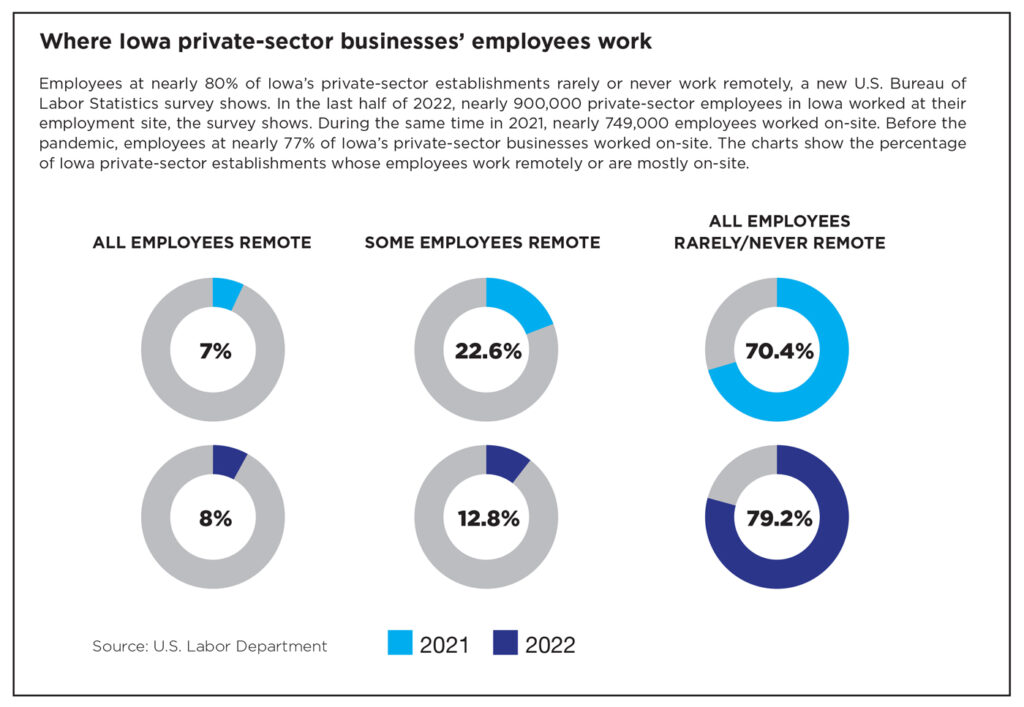Fewer businesses offering remote work, U.S. labor study shows
But workers still expect flexible schedules, leaders say

Kathy A. Bolten May 12, 2023 | 6:00 am
7 min read time
1,769 wordsBusiness Record Insider, Retail and BusinessDelta Dental of Iowa’s permanent post-pandemic work structure includes flexibility.
When the pandemic shuttered offices three years ago, employers were forced to find ways to keep workers productive as well as safe. Remote work became the solution. Now that the risks from COVID have diminished, employers are searching for ways to get workers into the office while continuing to allow the flexibility that remote work offers.
Delta Dental of Iowa, headquartered in Urbandale, settled on a solution that allows individual teams within the company to determine the number of days all of a group’s members are in the office together. Employees are also asked to be in the office during companywide events and meetings.
“Prior to the pandemic, we made the assumption that if people were in a seat and you could see them, they were doing their jobs,” said Jeff Russell, Delta Dental of Iowa’s president and CEO. “Everyone is thinking differently about that now. Still, if you don’t have those connections, you don’t build connectivity to the culture.
“The question is, how do you make sure that we are a team at a company as opposed to just a collection of individuals?”
While many company leaders believe offering employees flexibility in where they work is important, many also are pushing to get employees back on-site, a recent U.S. Department of Labor report shows.
Nearly 80% of private-sector business establishments in Iowa said their employees teleworked rarely or not at all during the last half of 2022, the report showed. That figure climbed from 70.4% the previous year and is nearing 82.4%, the level it was at in the months leading up to the pandemic.
Nationally, 72.5% of establishments said that in the last half of 2022 their employees rarely or never teleworked, according to the report. Before the pandemic, which began in March 2020, 76.7% of establishments said their workers rarely or never teleworked.
Downtown foot traffic
The decrease in remote work is evident by foot traffic counts in downtown Des Moines.
Downtown foot traffic averaged nearly 65% of pre-pandemic levels on Monday through Friday in the first quarter of 2023, according to a first-quarter report published by the Greater Des Moines Partnership. Downtown’s overall average foot traffic was 83% of pre-pandemic levels. The overall percentage was higher than the national Kastle Back to Work Barometer of 48%.
“What’s interesting, and this is a trend we’re hearing from around the region and from other communities, is foot traffic is elevated on Tuesdays, Wednesdays and Thursdays for traditional working hours, and our job is to continue to create reasons for people to come to the office on Mondays and Fridays as well,” Tiffany Tauscheck, chief operating officer and president of Downtown DSM Inc., said in a recent interview.
The decrease in remote work indicates more employers are bringing workers back to the office, which doesn’t surprise David Leto, president and CEO of the Palmer Group, a West Des Moines-based employment agency.
“The majority of leaders I speak with want to see their people on a regular basis,” Leto said. “Full remote work, while still prevalent, has lessened.”
Employers want workers in the office for several reasons; among them is training, Leto said. Companies that added new hires during the pandemic faced difficulties training them and immersing them into the company culture, he said.
“The unintentional training that happens during a day of work, when people are together, is pretty massive,” Leto said. “It’s challenging when people are sitting at home full time and not getting that exposure to their colleagues or their leaders in a physical environment. It’s difficult to build relationships with colleagues when people are not together, and it’s difficult for people to embrace the company’s culture.”
Before the pandemic, Palmer Group’s employees worked mostly in the office although the company provided a bank of hours each year in which employees could work remotely, Leto said. Now, about 40% of the firm’s 90 employees work in the office on a daily basis. The rest either work a hybrid schedule or are fully remote.
Regardless of whether people are in the office full time, hybrid, or remote, flexibility for employees – if responsibilities allow – is here to stay, Leto said.
A sampling of Iowa-based companies supports Leto’s belief that remote work will remain in place, at least in the foreseeable future.
Principal Financial Group, which has about 6,100 employees based in Des Moines, is continuing to offer employees a hybrid work arrangement, a company spokesperson wrote in an email. “Flexibility has played a critical role in the success of our culture,” the spokesperson wrote. “We understand the importance of empowering our leaders with the autonomy to have open conversations with their teams and implement the best work arrangements (remote, hybrid, or in-office) to meet customer needs.”
EMC Insurance Cos., which has about 1,100 employees in its downtown Des Moines office building, also is continuing to offer employees a choice about how and where they work, “with the expectation that we continue to provide exceptional customer service,” Beth Nigut, the company’s executive vice president, wrote in an email. Some positions require employees to work on-site; others allow for hybrid schedules or remote work, she wrote.
Casey’s General Stores Inc. also is allowing the estimated 1,000 employees who work in its corporate headquarters in Ankeny to decide by team group when team members will work in the office, said Katie Petru, a company spokesperson. Most teams are in the office three to five days a week, she said. “I think one of the biggest positives of having your team member base come back to the workplace is the element of collaboration and culture. We talk a lot about that here in terms of being able to have that in-person engagement.”
Hubbell Realty Co. has about 150 people who work in its corporate headquarters in West Des Moines. Before the pandemic, the company’s telecommute policy, which allowed employees to work remotely up to two days a week, was rarely used, said Claire Brehmer, a company spokesperson. Less than 10% of Hubbell’s corporate staff uses the policy. “Now, work from home is more widely accepted,” she said. Managers have “seen that productivity hasn’t slipped and, in some cases, it’s even increased.”

Hybrid-work schedules
After fears eased about COVID-19, many employers with office employees searched for ways to bring workers back to offices but also offer telework. Delta Dental of Iowa was no different.
In early 2022, Russell held meetings with groups of 20 workers at a time and asked them about the company’s hybrid work arrangements. He said he repeatedly heard that workers appreciated flexible work arrangements but missed the camaraderie that develops from working in an office.
What emerged from the meetings is what Russell describes as “a framework, not a policy.” Each Delta Dental of Iowa team decided what days all of their team members would be in the office. On Monday through Wednesday, between 55% and 70% of Delta Dental’s 185 employees are on-site, Russell said. About 40% are in the office on Thursday and Friday.
“Team Days” – when training and educational sessions or fun events like ice cream socials are held – occur twice a month. About 85% of employees are in the office on those days, Russell said.
“We’ve had some of our best service years since we’ve been in this hybrid structure,” Russell said. Service includes such things as the speed in which calls to Delta Dental’s call center are answered and the quality in which claims are processed.
“People can work from the place they need to work from,” Russell said. “If I’m working on processing or renewing a [policy], being at home and just being able to keep my head down may make a lot of sense. If I’m working on a project, being in the office and being collaborative is important.”
Demanding in-person work
Nationwide, public and private organizations are searching for ways to get more workers into the office on a regular basis. Some have used free food and other enticements to woo workers back to cubicles. In recent weeks, others have become more adamant about expectations for in-person work.
In a March memo from JPMorgan Chase & Co.’s operating committee, the company’s most senior employees were told that they must be in the office five days a week, according to several news reports.
Davis Polk & Wardwell LLP, a law firm headquartered in New York City, has told employees that they must adhere to its policy of spending at least three days a week in the office or risk seeing a reduction in bonuses, according to news reports. In February, Amazon Inc. CEO Andy Jassy wrote in a memo that corporate employees will be required to be in the office at least three days a week. Tim Cook, Apple Inc.’s CEO, made a similar announcement last August. Bob Iger, Disney Inc.’s CEO, has told corporate workers they must be in the office at least four days a week.
The federal government is also searching for ways to increase in-person work while still allowing the flexibility of remote work. In mid-April, the Office of Management and Budget issued a 19-page memo to top executive officers and agency leaders that includes guidelines for “measuring, monitoring and improving organizational health … and performance.”
The memo urged agencies to “substantially increase meaningful in-person work” at federal offices, particularly headquarters. “Meaningful in-person work” was described as work that is “purposeful, well-planned and optimized for in-person collaboration,” the memo said. The OMB also allowed for “flexible” operational policies that helped recruit and retain workers.
The federal government’s civilian workforce includes about 2.2 million people. About 47% of federal workers routinely or situationally worked remotely in the fiscal year that ended Sept. 30, 2021, according to the Office of Personnel Management.
Hybrid work structures aren’t going away, Leto said. “Flexibility for employees, if your job duties allow, is here to stay. I believe flexibility is the biggest deal to most employees and something they desire and very often will require as they consider their employment options.”
But, Leto added, leaders must find ways to balance the best interest of their company while crafting policies that will retain workers.
Russell also believes hybrid work schedules will be a permanent way that office-based establishments operate. Doing so will require leaders to think differently, he said.
“Companies that are trying to force people back into the office are maybe thinking about it in the wrong way,” Russell said. “We’re all relational, so how do we make sure we can balance that flexibility with that collaboration?”

Kathy A. Bolten
Kathy A. Bolten is a senior staff writer at Business Record. She covers real estate and development, workforce development, education, banking and finance, and housing.











